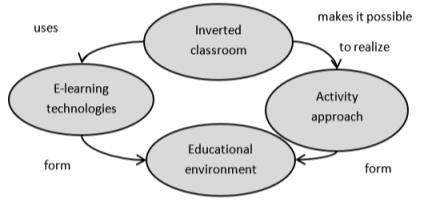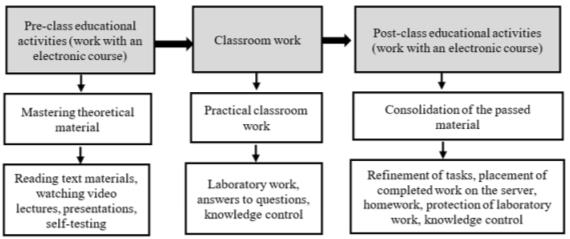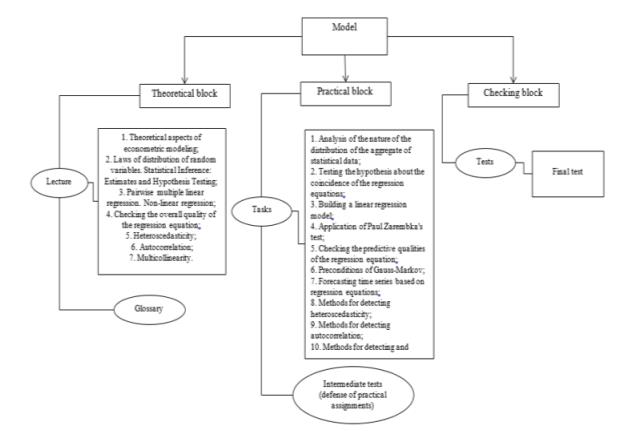Abstract
This article discusses the issues of using the blended learning model as a modern educational technology in higher educational institutions. Blended learning is designed to help overcome the disadvantages of technologies used today in the practice of educational activities. The aim of the study is to improve the quality of education based on the use of the rotational model technology, using which the so-called rotation of educational activities is carried out, that is, the redistribution of the ratio of traditional full-time classroom learning and online self-study in an individual mode. The authors carried out a review on the existing blended learning models used in the educational process at the present time. For use in the educational process, a rotational teaching model is proposed, namely, its version – «Inverted classroom». This is an innovative model, in which students are provided with theoretical material for independent study, and in the face-to-face practical lessons, the previously studied information is consolidated. On the basis of the federal state educational standard, the content of the course of the discipline is determined. Its methodological support has been developed and a model of a distance electronic course has been created for its subsequent introduction into the electronic information and educational environment of a higher educational institution.
Keywords: Quality, improvement, rotational model, education, e-learning environment
Introduction
The innovative changes that have been taking place recently in the field of education require new competencies from teachers of higher education, including in the application of modern teaching technologies. Blended learning technology that combines the electronic-distance component and contact communication between teachers and students is one of the current trends today.
Blended learning is an educational technology that combines training with a teacher (face to face) and training using information and communication technologies (Dolgova, 2017; Picciano, 2017; Wang, 2015). This approach combines the advantages of teaching in the classroom and the advantages of distance learning and implies the interaction of students in the electronic information environment of the university (Vasilina et al., 2017).
One of the means of implementing blended learning technology in higher education institutions is the creation of e-learning courses in disciplines. The main characteristic feature of the e-learning course is the presentation of educational material in a new interactive format, which has clear advantages for students (Margolis, 2018):
- providing an opportunity for students to study the theoretical and practical material of the course on an individual basis;
- ensuring self-study and self-control of students;
- obtaining round-the-clock access to information and methodological resources of the course;
- centralized organization of educational activities and control of its results;
- uniformity of presentation of educational material (Loginova, 2015).
Problem Statement
Improving the quality and increasing the effectiveness of the study of academic disciplines through the use of blended learning technology, implemented through the development of an electronic distance course.
Research Questions
- Describe blended learning as a modern educational technology.
- Consider and determine the content of the course on the example of one of the economic disciplines, taking into account the requirements of the Federal State Educational Standard.
- To develop a model of a distance course in the electronic educational environment of the Reshetnev Siberian State University of Science and Technology in order to improve the quality of education.
Purpose of the Study
Development of software and methodological support on the example of one of the economic disciplines in the implementation of blended learning technology.
Research Methods
Choosing a learning model
On the basis of the analyzed literature sources, among the obvious shortcomings of the traditional approach to teaching, one can single out: the average level and rate of presentation of educational material; impractical nature of the acquired knowledge; almost complete lack of feedback from student to teacher, and as a result - no adjustments to working methods; insufficient stimulation of the cognitive activity of students; the predominance of verbal methods of presentation; reproductive nature of learning, which focuses on the development of memory, not thinking. The desire to improve the learning process has led to innovative approaches to teaching.
Innovation - the introduction of a new or significantly improved method used in practice (GOST R 56261-2014, 2020).
At the first stage of the study, we will consider and determine the optimal type of blended learning model. To date, the authors identify six blended learning models with different goals, needs and costs.
1. Face-to-face Driver (a model aimed at reinforcing face-to-face traditional learning). In face-to-face classes, the teacher gives the bulk of the educational material, using the distance format as an auxiliary one. Very often this model includes classroom and laboratory work on computers (Nagaeva, 2016);
2. Rotation Model. This model is characterized by the alternation of full-time classroom training and independent e-learning in an individual mode (Ozerova & Lobodin, 2016);
3. Flex model. The bulk of the study time falls on distance learning, while students have the opportunity to receive advice from teachers offline at a convenient time for themselves on an individual schedule (Picciano, 2017);
4. Online Lab (online laboratory). The online platform is used to deliver the entire course of study in classrooms. Such training takes place under the guidance and supervision of a teacher (Pletyago et al., 2019);
5. Self-Blend Model. The student himself decides which of the full-time courses he needs to supplement with distance e-learning (Ashanina et al., 2021);
6. Online Driver Model (mainly online distance learning). Basically, this model assumes online training - through an information remote system and remote contact with a teacher. Testing classrooms and meetings with the teacher can be added (Pletyago et al., 2019).
These models are usually used in combination with each other. Consequently, «blended learning» is not ordinary classroom activities, since a student learns part of the educational material outside the classroom with a laptop or other technical means at a convenient pace. This is also not distance education, where the student receives practically no help from the teacher and appears in the classroom only to pass exams (tests). And this is not one-on-one study with a computer, the student must be part of the group and develop together with the group (Bekisheva, 2016).
After analyzing these blended learning models, we can say that basically they differ in the percentage of time allotted for traditional full-time and e-distance learning of students.
The first («Face-to-face Driver») and the second - the rotation model are characterized by a small share of classes with Web-support, within 1-29%. The use of a flexible model implies a reduction in classroom hours in favor of online classes (30-79% of the study time). When applied in the educational process of the «Online Lab» model, the share of online learning is 80-100%. The Online Driver Model plans to spend 100% of the study time in a distance format (Baidikova, 2020).
Thus, in our opinion, the most effective is the rotational model, where the so-called rotation takes place - a change of working zones, that is, an alternate change of face-to-face and remote modes of interaction between a teacher and students. When using the rotational model, the goal of training becomes to increase the effectiveness of training, due to the reallocation of time for access to training materials and their study (Rubtsov & Panich, 2016). Such presentation of educational material will allow to distribute the types of activities in the classroom and outside it, to take into account the personal characteristics of students (speed, pace of learning the material), as well as their needs. For the most effective implementation of the rotational model of blended learning in the study of disciplines, it is necessary to draw up a clear plan for the application of this technology. The teacher must first study the technical capabilities of students, assess the level of technological literacy, as well as the degree of preparation in working with modern information and communication technologies. In addition, it is also necessary to take into account the amount of time allotted for independent work of students, to which the creation of an electronic distance course is aimed.
Consider the main tasks that can be solved using the redistribution of classroom and e-learning:
- improving the quality of education (including through the use of more effective teaching aids);
- organization of individual support for the educational activities of each student;
- optimization of the learning process;
- improving the overall performance of students;
- acquisition of skills in working with modern information and communication technologies;
- gaining experience in offline mode (Nagaeva, 2016).
When planning the distribution of classroom and electronic-distance work of students, we used a variation of the rotational model of blended learning design «Inverted classroom» as a base. «Inverted classroom» is a teaching model in which the teacher provides students with theoretical material for independent study within the framework of the electronic-distance course, and practical consolidation of the material is carried out in the classroom (Figure 1).

The «Inverted classroom» rotational blended learning design model includes:
- familiarization with theoretical material on the topic (lecturing, viewing presentations, watching and listening to video and audio files);
- passing tests for the initial assimilation of the topic (Alisov & Podymova, 2021).
Classroom work is devoted to the analysis of the complex theoretical part and questions that have arisen among students in the process of studying theoretical material. Also in the classroom, under the supervision of the teacher, students are solving tasks for the practical part of the course (laboratory work). At the end of classes in the classroom, students independently complete work on practical assignments, undergo online testing to understand and consolidate the topic covered (Figure 2).

After choosing a blended learning model, we will move on to the next, second, stage of the study - filling the electronic distance course using the example of the discipline «Econometrics».
The content of the discipline «Econometrics» taking into account the requirements of the Federal State Educational Standard
The discipline «Econometrics» is included in the basic part of Block 1 «Disciplines (modules)» of the main professional educational program of higher education. The study of this course is closely related to such disciplines as «Economic statistics», «Probability theory and mathematical statistics». The knowledge, skills and abilities obtained in the course of studying the discipline «Econometrics» are necessary for studying such disciplines as «Methods of optimal decisions», «Research of operations in economics», «Macroeconomic planning and forecasting».
In accordance with the requirements of the Federal State Educational Standard, the main topics were formed for the study of the educational material of the discipline. Table 1 presents the topics that form the basis of the theoretical material that students study independently (Orlov, 2016).
Table 2 contains information about practical classes that are performed by students in the presence of a teacher.
At the third stage of the study, a model of an electronic training course was built for the placement of educational materials in Moodle.
Creation of a model of a distance course in the electronic educational environment of the Reshetnev Siberian State University of Science and Technology in order to improve the quality of education
To create the structure of the course, a branched model was used, which will show the hierarchy of information, combining it into groups (Figure 3).

The e-course consists of several blocks: 1. Theoretical (informational) block; 2. Practical block; 3. Communication and testing unit.
The theoretical (informational) block contains two components.
Information component: basic information about the studied electronic course; the volume and timing of the study of this course in hours and credit units; the schedule and sequence of studying the topics of the academic discipline; terms and forms of reporting; the schedule of practical and laboratory classes using modern electronic information and communication technologies of education; schedule of consultations.
Content component: work programs of the discipline; textbooks, collections of problems, teaching aids, guidelines, reference books and other information materials; detailed plans of seminars and laboratory classes; a list of basic and additional literature, including hyperlinks to the resources of the university's scientific library and electronic library systems; a list of topics for essays, essays for the effective organization of independent work of students in the discipline; reference materials for working with electronic materials.
The practical block includes: tasks for laboratory and practical exercises; information and reference documentation.
The communicative test block contains: test tasks for the implementation of the current, intermediate and final control of students' knowledge; control questions for current self-control; control questions for tests and exams; evaluation criteria.
Findings
Thus, our proposed rotational design model for blended learning «Inverted classroom» will allow you to effectively distribute the time of educational activities and improve the quality of education at the University due to its advantages:
- flexible learning process for students;
- openness of educational activities;
- a personal approach to each student;
- development of students' skills of independent work;
- the formation of the ability to work effectively in a group;
- increasing interest and motivation for educational and cognitive activities.
The model of the electronic educational and methodological course will serve as the basis for creating a convenient and functional information and communication resource that can meet the educational needs of students.
Conclusion
As a result of this study, a review of existing blended learning models was carried out. For implementation in the educational activities of the university in order to improve the quality of education, a rotational model of blended learning is proposed. The scientific and disciplinary specificity of the discipline has been determined. The content of the course of the discipline has been determined. Methodological support of the discipline «Econometrics» has been developed. A functional model of an electronic educational-methodical course has been created.
References
Alisov, E. A., & Podymova, E. A. (2021). History of the development of educational models and technologies: textbook. Direct-Media, 353. [in Rus.].
Ashanina, E. N., Vasina, O. V., & Ezhova, S. P. (2021). Modern educational technologies: a textbook for universities. (2nd Ed.) Revised. and add. Yurayt Publishing House. [in Rus.].
Baidikova, N. L. (2020). Cyclic model of blended learning: a technological approach. Concept, 1, 39-50. [in Rus.].
Bekisheva, T. G. (2016). Blended learning: current trends in universities. Russian Journal of Education and Psychology, 11-2(67). 37-42. [in Rus.].
Dolgova, T. V. (2017). Blended learning - innovation of the XXI century. Interactive education, 5, 2-8. [in Rus.].
GOST R 56261-2014. (2020). «Innovation management. Innovation. Basic Provisions».«Standartinform». [in Rus.].
Loginova, A. V. (2015). Blended learning: advantages, limitations and concerns. Young scientist, 7(87), 809-811. [in Rus.].
Margolis, A. A. (2018). What mixes blended learning? Psychological Science and Education, 23(3), 5-19. [in Rus.].
Nagaeva, I. A. (2016). Blended learning in the modern educational process: necessity and opportunities. Domestic and foreign pedagogy, 6(33), 56-66. [in Rus.].
Orlov, A. I. (2016). Modern econometric methods - intellectual tools of an engineer, manager and economist. Scientific Journal of KubSAU, 116, 112-143 [in Rus.].
Ozerova, G. P., & Lobodin, P. N. (2016). Using a blended learning model for organizing the educational process at a university. Open and distance education, 3(63), 11-19 [in Rus.].
Picciano, A. G. (2017). An integrated Multimodal Model for Online Education. Theories and frameworks for online education: Seeking an integrated model. Online Learning, 21(3), 166-190.
Pletyago, T. Yu., Ostapenko, A. S., & Antonova, S. N. (2019). Pedagogical models of blended learning at a university: generalization of the experience of Russian and foreign practice. Education and Science, 21(5), 113-129. [in Rus.].
Rubtsov, G. I., & Panich, N. V. (2016). Blended learning: analysis: interpretations of the concept. Domestic and foreign pedagogy, 5(32), 102-108. [in Rus.].
Vasilina, D. S., Nurieva, G. Yu., & Yulanova, D. M. (2017). Information and educational environment of a modern university. Izvestia VSPU, 2(115), 8-12. [in Rus.].
Wang, Y. (2015). Revisiting the Blended Learning Literature: Using a Complex Adaptive Systems Framework. Educational Technology & So-ciety, 18(2), 380-393.
Copyright information

This work is licensed under a Creative Commons Attribution-NonCommercial-NoDerivatives 4.0 International License.
About this article
Publication Date
25 September 2021
Article Doi
eBook ISBN
978-1-80296-115-7
Publisher
European Publisher
Volume
116
Print ISBN (optional)
-
Edition Number
1st Edition
Pages
1-2895
Subjects
Economics, social trends, sustainability, modern society, behavioural sciences, education
Cite this article as:
Yuferowa, N. U., Abakumova, Z. V., Levshina, V. V., & Savchik, E. (2021). Innovative Approaches To Improving The Quality Of Education At The University. In I. V. Kovalev, A. A. Voroshilova, & A. S. Budagov (Eds.), Economic and Social Trends for Sustainability of Modern Society (ICEST-II 2021), vol 116. European Proceedings of Social and Behavioural Sciences (pp. 2382-2390). European Publisher. https://doi.org/10.15405/epsbs.2021.09.02.266

